| dc.contributor.author | Volden, Gro Holst | |
| dc.date.accessioned | 2019-04-01T06:50:28Z | |
| dc.date.available | 2019-04-01T06:50:28Z | |
| dc.date.created | 2018-10-22T15:12:04Z | |
| dc.date.issued | 2018 | |
| dc.identifier.citation | International Journal of Managing Projects in Business. 2018, 1-21. | nb_NO |
| dc.identifier.issn | 1753-8378 | |
| dc.identifier.uri | http://hdl.handle.net/11250/2592578 | |
| dc.description.abstract | Purpose
The purpose of this paper is to explore the adverse incentives at the front end of government-funded projects with concentrated benefits and no liabilities for the privileged groups. In particular, the author discusses the risk of perverse incentives of the types typically found in the development aid sector that results in counterproductive outcomes.
Design/methodology/approach
The paper uses a simple conceptual framework based on agency theory. A qualitative, case-based approach with purposive sampling was chosen for the empirical part of the study. Eight Norwegian projects were selected because incentive problems were to be expected, and one development aid project served as a reference case.
Findings
The paper finds that low strategic project success corresponded well with the terms of financing. There were clear indications of agency problems, in three cases to the extent that the incentives turned perverse. The paper concludes with a discussion of relevant measures to prevent the emergence of perverse incentives.
Originality/value
The paper contributes to an improved understanding of the incentives related to public project initiation and selection, which is an under-researched topic and generally not included in formal project governance schemes. The research should therefore be useful to scholars as well as practitioners within the field of project governance. | nb_NO |
| dc.language.iso | eng | nb_NO |
| dc.publisher | Emerald | nb_NO |
| dc.rights | Navngivelse 4.0 Internasjonal | * |
| dc.rights.uri | http://creativecommons.org/licenses/by/4.0/deed.no | * |
| dc.title | Public funding, perverse incentives, and counterproductive outcomes | nb_NO |
| dc.type | Journal article | nb_NO |
| dc.type | Peer reviewed | nb_NO |
| dc.description.version | publishedVersion | nb_NO |
| dc.source.pagenumber | 1-21 | nb_NO |
| dc.source.journal | International Journal of Managing Projects in Business | nb_NO |
| dc.identifier.doi | 10.1108/IJMPB-12-2017-0164 | |
| dc.identifier.cristin | 1622350 | |
| dc.description.localcode | © Gro Holst Volden 2018. Published by Emerald Publishing Limited. Open Access. This article is published under the Creative Commons Attribution (CC BY 4.0) licence. Anyone may reproduce, distribute, translate and create derivative works of this article (for both commercial and non-commercial purposes), subject to full attribution to the original publication and authors. The full terms of this licence may be seen at http://creativecommons.org/licences/by/4.0/legalcode | nb_NO |
| cristin.unitcode | 194,64,91,0 | |
| cristin.unitname | Institutt for bygg- og miljøteknikk | |
| cristin.ispublished | true | |
| cristin.fulltext | original | |
| cristin.qualitycode | 1 | |

